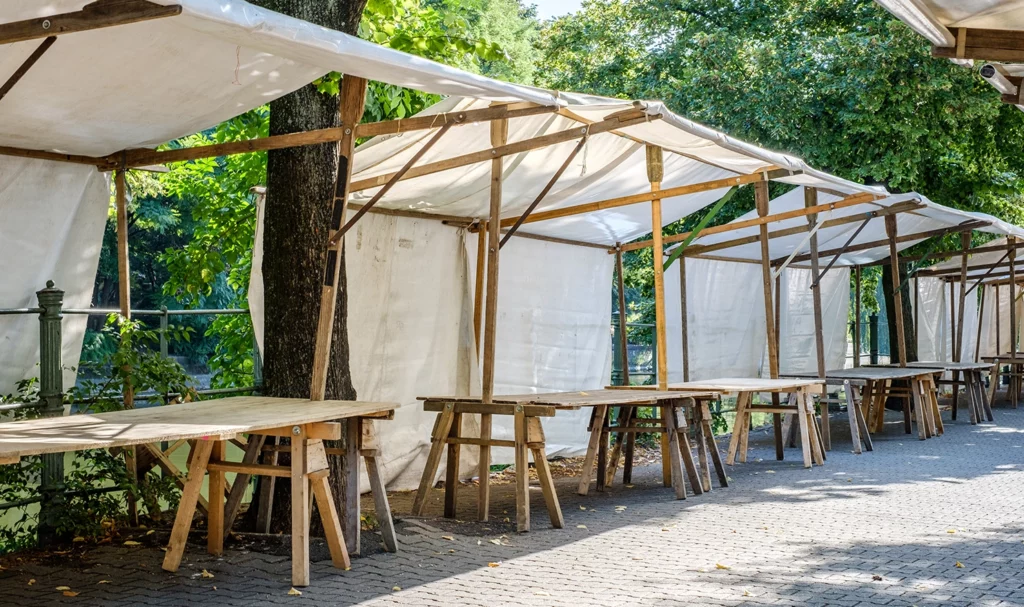Let’s be real: you probably feel like you’ve heard it all when it comes to making your booth stand out. But after spending time researching and hearing what you “should” do, the real question is: will it actually work for your booth?
That’s where knowing how to brand a farmers market booth effectively can set you apart from the crowd.
Crafting a Brand That’s Uniquely Yours
Brand identity is more than your logo, a name, or a slogan — it’s everything you do to connect with your customers. When branding a farmers market booth, you need to dig deeper into who you are and what sets you apart from competitors.
1. Define Your Core Values
Start by reflecting on the “why” behind your business.
- Why do you make the food you make?
- What values drive your business?
- What are you truly passionate about?
These values form the foundation of your brand. They help you connect with customers who share similar beliefs and expectations, guiding your booth setup, products, and overall experience.
2. Identify Your Unique Selling Propositions (USPs)
Your unique selling propositions (USPs) are the things you do that your competitors might not do (or not do as well). These USPs solve specific problems for your customers, such as offering locally sourced foods or unique flavors.
To find them, ask yourself:
- What makes your food and booth different?
- What are you doing that your competitors aren’t?
- What problem are you solving for your customers?
Defining these USPs helps you position your brand clearly in a crowded market.

3. Get to Know Your Customers
The better you know your customers, the easier it is to tailor your farmers market booth branding to their needs.
Are they moms looking for fresh produce? Millennials seeking quick, healthy snacks? Foodies searching for bold, unique flavors? Really get to know them with these tactics:
- Start by defining their demographics, lifestyle, and values
- Understand what products they’re likely to buy
- Discover which markets they frequent
- Nail down how they respond to marketing
Take everything you learn and create a buyer persona (perhaps with the help of free artificial intelligence (AI) tools, like Ignition’s persona generator). This will give you a robust picture of your ideal customer, which should guide your decisions on pricing, messaging, and booth design moving forward.
4. Personify Your Business
Think about your brand as if it were a person. What personality traits would it have? Would it be:
- A fun, playful friend
- A serious, professional farmer
- A quirky, approachable neighbor
- An elegant, refined professional
Now think about how your brand would speak to your customers. The tone of voice you use should align with the personality you want to convey, whether it’s friendly, humorous, inspiring, or educational.
The personality should remain consistent across all branding efforts, from your booth design to your business cards to your social media posts — you see where I’m going with this? Wherever you go, your customers will recognize your brand.
Pro Tip: Use psychological marketing techniques like alliteration, repetition, or rhyming in your branding (e.g., your booth name or tagline). These techniques make your brand easier to remember.
5. Design Eye-Catching Visuals
Choose colors that reflect your brand’s personality and values. For example, earthy tones might suggest sustainability, while vibrant colors could evoke excitement and fun.
Apply some color psychology to pick something that pops:
- Green conveys health and freshness
- Red stimulates the appetite
- Blue evokes trust and professionalism
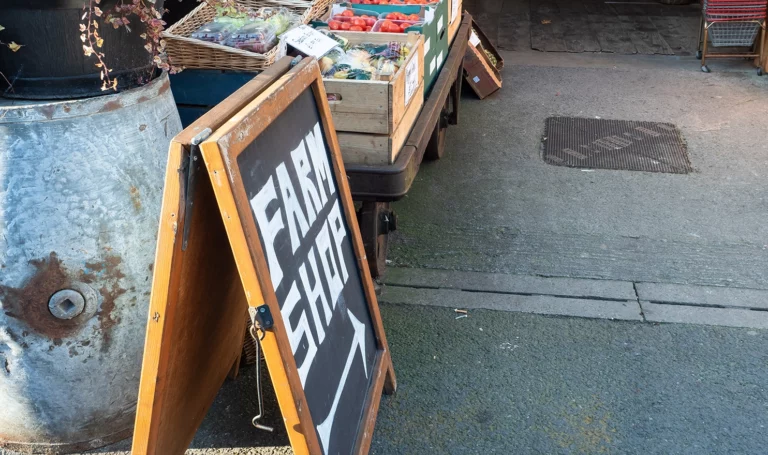
6. Write Your Brand’s Story
People connect with stories. Share the story behind your business, whether it’s a family recipe, inspiration from a trip abroad, or a heartfelt mission.
A compelling story makes your booth more approachable and relatable, giving customers a reason to care about your product beyond just the food.
It also helps you position your product within the broader market. Are you offering premium, high-end items or affordable, everyday options? Your brand’s story gives customers compelling reasons to choose your product over others.
Pro Tip: Signs usually just list what something is and the cost. Adding “handmade,” “family recipe,” “gluten-free,” or “zero preservatives” shows the value, not just the cost. A small sign sharing your “why” or origin story creates an emotional connection.
7. Keep Your Brand Consistent
Create a brand guideline that includes sections like your:
- Logo
- Color palette
- Font choices
- Tone of voice
This ensures consistency in all your marketing materials, from signage to packaging. Consistency is key here!
As you expand, your brand book helps you guarantee that anything new you do will align with your established brand.
8. Test, Test, and Test Again
Once you’ve built your brand identity, test it with your customers to see how they respond:
- Do they connect with your brand story?
- Do they understand what makes your business unique?
- Do they want to interact with your business because of the brand?
Gather feedback by distributing a Google survey through email or running social media polls to gather immediate insights. You could also test some small changes first and ask for verbal feedback from your customers at your next market.
No matter how you test, be open to refining your brand as your business grows. The good news is, your brand identity isn’t set in stone. You can continue evolving, but always stay true to your core values.
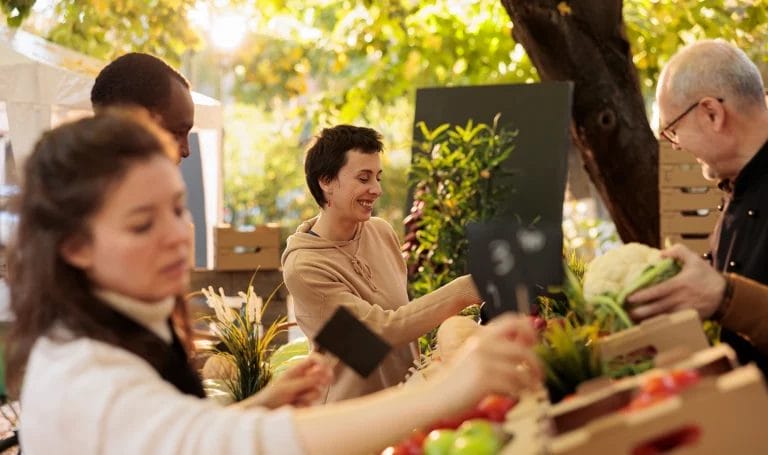
Transforming Your Booth Into a Brand Experience
Remember how we personified your brand earlier? Now, imagine that brand standing next to you at a market…
How would it set up a booth? What would the vibe be? What would it say?
This exercise helps you create a functional booth that reflects your brand identity.
It’s All in the Details
Your booth setup should be a physical extension of your brand’s personality.
For example, a farm-to-table brand might not use a generic folding table. Instead, they use a second-hand kitchen table and bench. Their products are displayed in wooden crates and rustic barrels.
Small design choices like this help customers visualize your products in their everyday lives, immerse themselves in your brand, and feel invited into the atmosphere of your space.
Making a Big Impact Without Breaking the Bank
Branding doesn’t have to come with a hefty price tag! You can boost your booth’s presence with affordable farmers market booth branding that’s simple, affordable, and deeply personal.
Elevate the Customer Experience
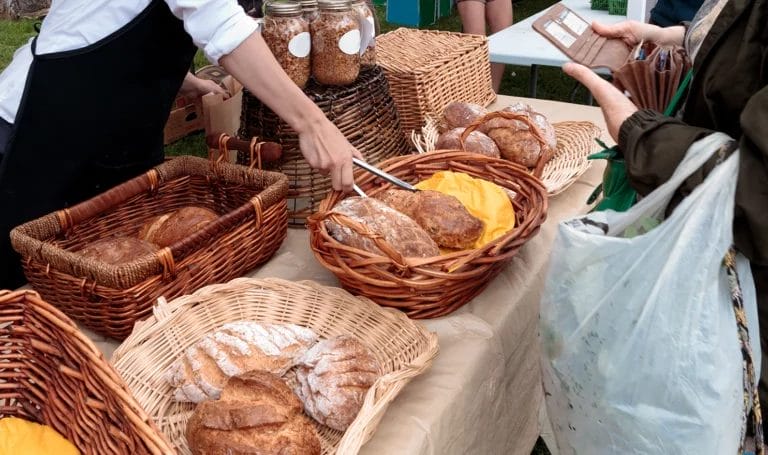
Creating a welcoming atmosphere, offering personalized service, and engaging with customers can turn first-time buyers into loyal fans.
- Don’t have your face buried in your phone
- Try sitting in a taller chair to remain at eye level
- Maintain a friendly, approachable attitude
- Strike up conversations without being pushy
- Share the inspiration behind your products
Pro Tip: Your small business might not be a household name, but that doesn’t mean you can’t become their favorite farmers market staple! Refining your customer service skills can set you apart from the competition and build a loyal customer base.
Pay Attention to Packaging
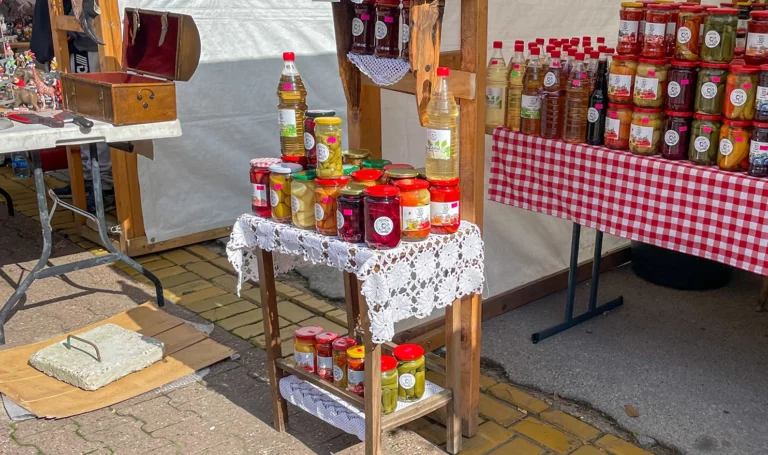
Make your booth feel personal with custom packaging, labeling, or wrapping. Even something as simple as a brown gift bag with your logo stamped on it or a handwritten thank-you note on the back of your business cards leaves a lasting mark.
Pro Tip: Many vendors use generic labels or packaging that doesn’t reflect the quality of their product. Using affordable branding kits (like Canva templates or local print shops) to make clear, cohesive packaging can elevate the perceived value of your products.
Don’t Discount the Idea of Deals

Yes, affordable farmers market booth branding can include deals! You just have to be strategic:
- Loyalty programs, such as punch cards, are an excellent way to encourage repeat business (and they can be especially effective during seasonal markets)
- Offering a 10% discount on a future purchase as a thank you for shopping your booth helps keep customers engaged without eating into your event profits
- For those with a large inventory of smaller items, bulk promotions like “Buy three, get one free” help you move products quickly while boosting your overall sales
Here’s the secret: deals make happy customers, and happy customers tell their friends about you. Turning happy customers into brand advocates is one of your most powerful (and affordable) tools.
How Good Branding Positions Your Stall for Success
Dialing in your branding is about strengthening your connection with customers and setting your business up for long-term success. Even minor adjustments in your approach to branding can have a significant impact and help you:
⭐ Stand out in a crowded market
⭐ Attract more customers
⭐ Foster lasting relationships
“Can Branding Really Help Me Sell More?”
Branding a farmers market booth directly helps you sell more because it:
- Builds your reputation
- Increases recognition
- Signals trust and credibility
- Differentiates you from competitors
- Nurtures brand loyalty
- Creates consistency
Sure, the guy in the stall next door using strobe lights and loud music will probably draw a crowd in a lot faster than you. But the likelihood of those people sticking around to buy something is far less. A crowded booth doesn’t always equal cash sales!
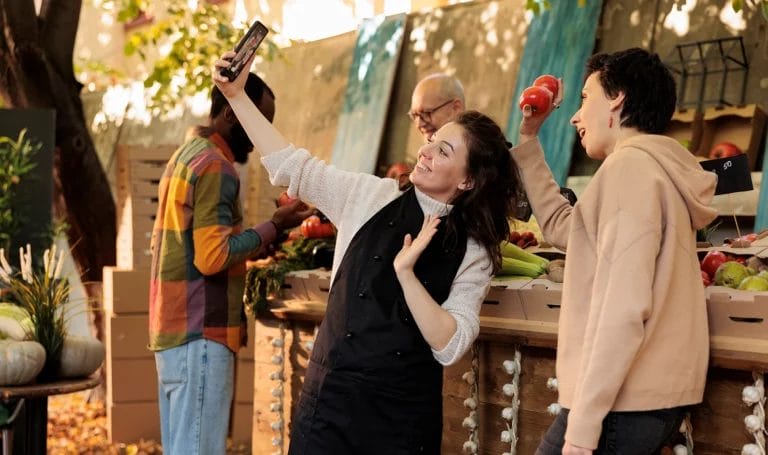
Insurance Is the Secret Ingredient to Enhancing Credibility
Markets that require insurance show they prioritize safety and professionalism — wouldn’t you want your business to project the same image?
In the food industry, customers often expect businesses to be fully compliant with rules and regulations. Not having insurance might surprise them (and not in a good way!). Farmers market insurance = more trust in you.
Most markets also require vendors to carry insurance, so having a policy not only keeps you compliant but also signals to customers that you’re prepared to take care of them if something goes wrong. Win over your customers and start winning at your sales, too!
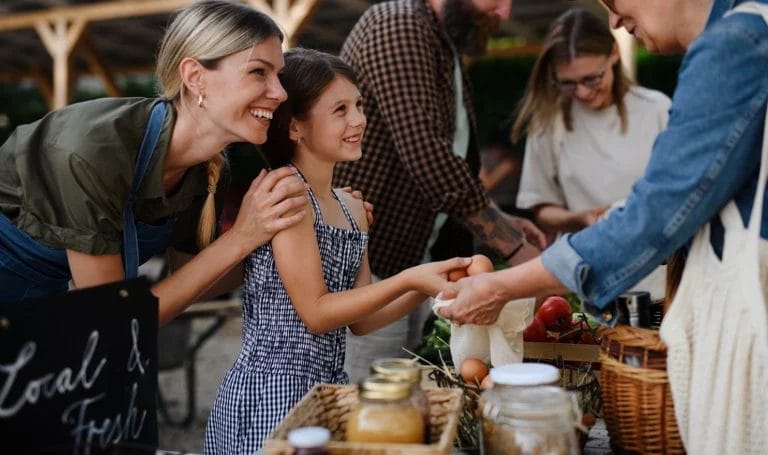
FAQs About Farmers Market Booth Branding
How Do I Choose a Color Scheme for My Booth?
Use these tips to choose a color scheme for your booth:
- Choose the mood and traits you want your brand to convey
- Consider color psychology and how it impacts buying decisions
- Analyze your competitors’ color schemes to find ways to stand out
- Select colors that work well across different digital formats
- Pick two to three main colors, along with a few accent colors
- Test your color choices in the real world and adjust as needed
Do I Need a Professional Logo?
No, you do not need a professional logo — but you do need a logo, even if you make it yourself! A logo boosts your credibility and brand recognition. It makes it easier for customers to recognize and return to your booth.
A professional, well-designed logo made by a designer can enhance your professionalism, elevate your brand, and make your booth stand out!
What Should I Include on My Signage?
At a minimum, you should include your name, logo, tagline, social media handles, and pricing on your signage. To make your booth stand out, you can also add:
- Customer reviews and testimonials
- A call to action, like an email sign-up or review form
- QR codes to complete a custom order form
- In-depth product descriptions
- Your business contact information
What’s the Best Way to Display Prices?
The best way to display prices is on large, easy-to-read signs. This makes it easy for customers to understand your pricing quickly and keep things cost-efficient for you.
Using printed or letterboard signs is always a safe bet, since some handwriting can look illegible or accidentally wipe off.

Alex Hastings
Seattle-based copywriter and (WA) licensed insurance agent Alex Hastings leverages her experience as a lover of fast-casual food, baked goods, and iced oat milk lattes. She holds a B.A. in Creative Writing from Western Washington University. Before working at Veracity, she was a retail copywriter at Zulily and an English language teacher in South Korea. Alex is fully trained on FLIP insurance coverages and writes content that connects food and beverage business owners with the policies they need.
Seattle-based copywriter and (WA) licensed insurance agent Alex Hastings leverages her experience as a lover of fast-casual food, baked goods, and iced oat milk lattes. She holds a B.A. in Creative Writing from Western Washington University. Before working at Veracity, she was a retail copywriter at Zulily and an English language teacher in South Korea. Alex is fully trained on FLIP insurance coverages and writes content that connects food and beverage business owners with the policies they need.

